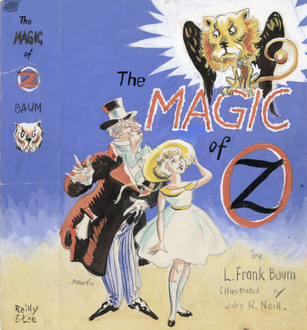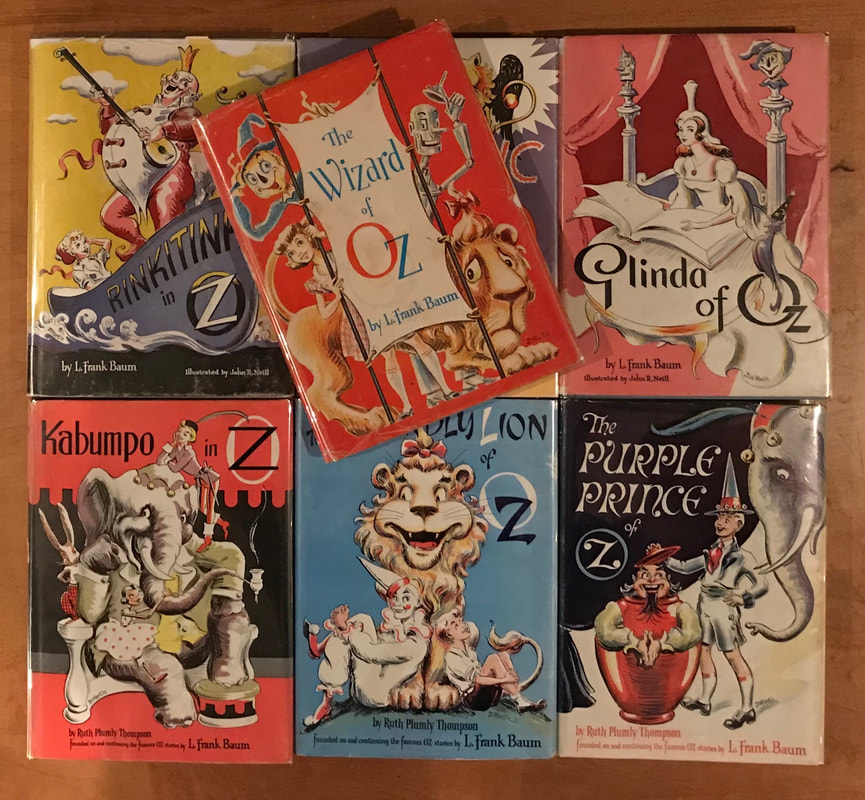|
The International Wizard of Oz Club is featuring a recurring column contributed by 'The Lost Art of Oz.' in their publication, The Baum Bugle. The following first appeared in the Winter 2019 edition.  Dick Martin in the late 1950s. Dick Martin in the late 1950s. Roughly 4,000 illustrations were created for the canonical "Famous Forty" Oz books, perhaps the most popular and best-selling American children’s series of the early 20th century. By my approximation, less than ten percent of the final original artwork drawn by W. W. Denslow, John R. Neill, Frank Kramer, ‘Dirk,’ and Dick Martin for the series is known to survive (367 pieces, as of this writing, if you want to be succinct). My journey to discover how most of this artwork disappeared—almost all of it created, ‘for hire,’ for the publisher, Reilly & Britton (later Reilly & Lee)—led, in the fall of 2018, to the creation of my online project, The Lost Art of Oz. In my eagerness to quell personal curiosity, catalogue the surviving original illustrations, and hopefully pave the way for more Oz artwork to be found, I should have guessed Baum and his illustrative collaborators, even from the great beyond, would weave a cosmic quest of adventure. The riddle of what became of this artwork would reveal its own fables of mind, heart, and moxie. The journey would also lead to a lesson in the evolution of what constitutes "art" and the reality that by the time it is usually recognized as such, much of the physical artform has already gone by the wayside. Most of all, I would discover the brilliance of a series of men—drafters, painters, skechers, fine line masters—who never considered themselves "artists." These were American illustrators, whose individual and collective imaginations helped lay the foundation of a pop culture phenomenon that lives on—and continues to build on—their imaginations a century later. The first three decades of the 20th Century marked the heyday of "Ozmania," but by the late 1950s, Reilly & Lee was floundering. Artist and lifelong Oz fan Dick Martin went to work for the publisher in 1957; with little offered monetarily, Martin reportedly often worked for the company in trade, bartering his artistic services for compensation with treasures out of the Reilly & Lee archives. Among those treasures were all the finished illustrations John R. Neill had drawn for the Oz books—or what was left of them. By the late 1950s, the Reilly & Lee archives were largely in tatters. Years of building moves, neglect, and lax lending (and unofficial borrowing) had left Neill’s collection of original artwork, drawn in pen and ink on bulky Bristol board, both spotty and spotted. In 1959, Reilly & Lee was sold to Regnery Publishing. When it was discovered that most of the original Neill "key art" required to reprint the series’ cover and jacket designs was missing, Roland Roycraft, art director for Regnery’s advertising agency, Kencliffe, Breslich & Company, was enlisted to redraw the covers to match Neill’s art. After sampling Roycraft’s reconstructions, Henry Regnery decided a more contemporary look might better serve Oz in the mid century, and Roycraft was instead directed to create new bold, cartoonish covers (perhaps befitting a youth culture being weaned on Howdy Doody and Huckleberry Hound). Facing a public who thought Oz increasingly pasee, as well as solidifying condemnation from vocal detractors in the public library system who, for decades, had banned the Oz series, Regnery quickly made an about-face and realized that his greatest hope to save the languishing Oz series was to position them as American classics. Dick Martin, whose traditional artistic aesthetic blended 1950s homespun Americana with the whimsy of John R. Neill and the comic strip accessibility of W.W. Denslow, suddenly found himself, at last, in the Oz spotlight. In 1960, Martin not only illustrated The Visitors from Oz, a new adaptation of Baum’s 1904 newspaper strip, "Queer Visitors from the Marvelous Land of Oz," he also drew new dust jacket designs for ten volumes of the classic series.
Martin’s new jacket designs for the Oz series were vibrant, inviting, and ultimately short-lived. In 1964, perhaps riding a new wave of Oz nostalgia fueled by yearly telecasts of the 1939 MGM film, Regnery decided to revisit the publication of the Oz books yet again. Narrowing public focus by discontinuing all but the Baum titles in the series, he again asked for the recreation of John R. Neill’s classic cover designs. A brilliant artistic mimic, Martin was assigned the task, and the publication of what is now known as the "white editions" in 1964 helped usher in a new generation of Oz fans, and finally saw the Oz books become staples in the American public library system. Dick Martin retained the original artwork he created for The Visitors from Oz and his dust jacket designs, and perhaps wishing to pay forward the gift he felt in obtaining priceless original Oz art treasures from the Reilly & Lee archives earlier his career, offered them as gifts and to be sold at convention auctions benefitting the International Wizard of Oz Club. Dick Martin would also become the last "official" illustrator of Oz, when Regnery, under the Reilly & Lee imprint, issued one final Oz book, Merry Go Round in Oz by Eloise Jarvis McGraw and Lauren McGraw Wagner, in 1963. This time, the final artwork by Dick Martin would take its place alongside most of the illustrations drawn for the Oz series by his artistic predecessors; likely drawn "for hire," it is now presumed lost as well. Special thanks to Andrea Grimes at the San Francisco Public Library, and to Bill Campbell of The Oz Enthusiast for providing photographs. Dick Martin The Magic of Oz Drawings (BASC 12), Book Arts & Special Collections, San Francisco Public Library
1 Comment
|
AuthorBrady Schwind is a writer, director, and Oz Enthusiast on a mission to definitively catalogue the existing original artwork from the famed "Famous Forty" Oz books. Archives
November 2023
Categories |




 RSS Feed
RSS Feed
